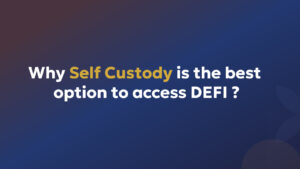 The global crypto user base has risen nearly 100 times between 2016 and 2023, and it continues to soar. The rising interest in cryptocurrencies like Bitcoin and Ethereum is a testament to the increasing adoption of DeFi (decentralized finance). This adoption comes after the realization of the benefits a digital and decentralized economy possesses.
The global crypto user base has risen nearly 100 times between 2016 and 2023, and it continues to soar. The rising interest in cryptocurrencies like Bitcoin and Ethereum is a testament to the increasing adoption of DeFi (decentralized finance). This adoption comes after the realization of the benefits a digital and decentralized economy possesses.
However, the biggest irony is that existing custodians of digital assets are largely centralized. Be it crypto exchanges or asset management firms, most of them have a centralized architecture with a single point of failure.
This centralized architecture contradicts the basic idea of DeFi, i.e. democratization of digital finance with decentralization being a key trait. The centralized asset management architecture is a major roadblock in the bass adoption of DeFi, both from retail as well as institutional perspectives.
To boost this decentralized ecosystem, we truly need digital asset custody that extends to providing self-custody wallets with the best infrastructure supporting secure custody, robust governance, top-notch asset management tools, and easy access to leading DeFi dApps.
More Institutions Are Embracing DeFi
The decentralization in DeFi still needs to be included, with a single database in the custody of funds. This is the era where more and more institutions are embracing DeFi with a promise to offer total transparency to customers while retaining the trait of decentralization.
According to a survey by Chainanalysis, large institutional transactions – those above $10m – accounted for over 60 percent of all DeFi transactions in Q2 2021. With banks like JP Morgan and Morgan Stanly embracing DeFi and institutions like BlackRock getting spot Bitcoin ETF approval, institutions pouring millions of dollars into DeFi are about to become a new normal.
However, this doesn’t change the fact that centralized custodians are in charge of the majority of assets in DeFi.
The Challenges With CeFi
By design, centralized exchanges maintain authority over users’ private keys and possess the capability to suspend access to digital assets. This structure exposes users to potential risks from law enforcement, regulatory interventions, and a wide array of vulnerabilities associated with centralized intermediaries, encompassing operational, technical, and security concerns.
Exchanges halting withdrawals during market dumps are now a frequent phenomenon. The recent FTX fiasco is an example of what can go wrong with centralized custody. There is a long list of centralized custodians falling prey to a cyberattack or corruption by an insider. Who faces the brunt of such events? Users, of course.
As the horizon of DeFi gets wider with institutional money pouring in, a lot is at stake than ever before.
MPC-As-A-Solution
Realizing the need to enhance security, institutions have already started implementing highly secure MPC wallet (multi-party computation) wallets to enhance security with the help of traditional custody solution providers.
But there’s a catch. Custodians still retain the right to control consumer funds as these funds are stored on a centralized database. Hence, funds still remain vulnerable to cyberattacks or mismanagement by an insider. While the risk induced by a single point of failure is reduced substantially, achieving decentralization remains a challenge.
The Road To Decentralization: Self-Custody Of Assets
Self-custody is a self-explanatory term. It refers to a setup where users/institutions retain the custody of their assets. In order to enable total decentralization and transparency, self-custody is the first step. As Binance’s ex-CEO CZ says, “Self-custody is a fundamental human right.”
Opting for self-custody wallets presents numerous benefits compared to relying on centralized custodians. Firstly, they remove the necessity for users to place trust in a third party with their assets, minimizing the potential for hacks, fund losses, or security breaches. Secondly, these wallets empower users to retain absolute control over their funds and private keys, granting them the freedom to conduct transactions with their cryptocurrency assets according to their preferences.
While traditional custodians propose to offer advanced security features in the form of multi-sig and MPC wallets, centralization remains. The void is filled by innovative custody solution providers like Liminal that combine MPC and self-custody to provide the best of both worlds.
A self-custody solution like Liminal allows retail users and institutions to access DApps through wallets like MetaMask, WalletConnect, etc. Tailor-made for institutions, Liminal combines Multi-Sig and MPC technology with an enterprise-grade Firewall to solve the wallet ownership and workflow problem in custody.
It allows institutions to solve signer distribution, create complex policies suiting organizational requirements, and implement rule-based settings to attain fluid transaction processing and management. While top-of-the-line security certifications like ISO 27001&27701, SOC Type II, and CCSS level 3 fortify the security of institutions’ digital assets, tiered insurance protection ensures that access to funds is not lost even in the worst-case scenario.
Benefits Of Self Custody In DeFi
Self-custody in decentralized finance (DeFi) offers a range of advantages that align with the principles of autonomy, security, and user control:
Enhanced Security: Self-custody empowers users with control over their private keys, reducing the risk of unauthorized access or potential security breaches associated with centralized custody solutions. It allows institutions to implement their own security measures and protocols.
Greater Autonomy: Institutions maintain complete ownership of their digital assets and have the autonomy to make decisions without relying on third-party custodians. By doing so, self-custody solutions promote user sovereignty, aligning with the decentralized nature of DeFi.
Unlocked Access to DeFi: Not bound by any limitations imposed by centralized custodians, users can seamlessly access and engage with a diverse range of DeFi protocols, platforms, and applications.
Zero Counterparty Risk: Self-custody allows institutions to mitigate counterparty risk since they are not relying on external entities to safeguard their assets. This reduces vulnerability to potential insolvency or malpractice associated with centralized custodians—no more cases like the FTX fiasco.
Interoperability: Innovative self-custody solutions promote interoperability, allowing users to interact seamlessly with different DeFi applications and platforms. As more and more assets move on-chain, interoperability is a prerequisite for increased adoption.
Final Word
Centralized custodians have enjoyed a monopoly in the digital asset space for long. This has prevented institutions from aligning with the key principles of DeFi, i.e., decentralization, transparency, and scalability. Innovative digital asset custodians like Liminal promote self-custody without compromising on security.
In fact, modern-day custodians offer much more than security. They help institutions enforce customized rules to serve organizational needs and comply with regulatory regulations. Third-party custody is set to change a lot with innovative solutions putting users in control of their assets while retaining the load of security. With more institutions jumping on the bandwagon, self-custody is not an option but a necessity.






Leave a Comment
You must be logged in to post a comment.